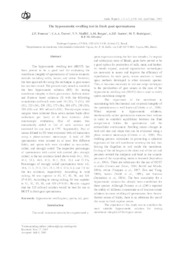The hypoosmotic swelling test in fresh goat spermatozoa.
The hypoosmotic swelling test in fresh goat spermatozoa.
Resumo: The hypoosmotic swelling test (HOST) has been proved to be a good tool for evaluating the membrane integrity of spermatozoa of various domestic animals including cattle, horses, and swine. However, the best approach for using this technique in goat semen has not been tested. The present study aimed to establish the best hypoosmotic solution (HS) for testing membrane integrity in fresh goat semen. Sodium citrate and fructose based solutions (S) with the following osmolarities (mOsm/l) were used: 50 (S1), 75 (S2), 100 (S3), 125 (S4), 150 (S5), 175 (S6), 200 (S7), 250 (S8), 290 (S9) and 300 mOsm/l (S10). Twenty-eight semen samples were collected from seven mature bucks (four collections per buck) at 48 hour intervals. After macroscopic evaluation, 10?l of semen was immediately added to 2ml of each solution and incubated for one hour at 37ºC. Sequentially, 20?l of semen diluted in HS were evaluated with oil immersion using a phase-contrast microscope. A total of 200 spermatozoa were counted in at least five different fields, and sperm tails were classified as non-coiled, coiled, and strongly coiled. The respective percentages of spermatozoa with coiled tails (coiled plus strongly coiled) in the ten solutions listed above were 34.1, 38.8, 45.3, 51.5, 46.8, 42.8, 38.2, 29.0, 19.4 and 23.1%. Percentages of strongly coiled spermatozoa were: 6.8, 10.6, 21.5, 25.3, 24.3, 21.5, 19.3, 12.4, 6.4, and 7.9 for the ten solutions, respectively. According to total coiling, S4 was superior to S1, S7, S8, S9, and S10 (P<0.05). According to strong coiling, S4 was superior to S1, S2, S8, S9, and S10 (P<0.05). Results suggest that the 125 mOsm/l solution would be best for use in HOST in fresh goat spermatozoa.
Ano de publicação: 2005
Tipo de publicação: Artigo de periódico
Unidade: Embrapa Caprinos e Ovinos
Observações
1 - Por padrão são exibidas publicações dos últimos 20 anos. Para encontrar publicações mais antigas, configure o filtro ano de publicação, colocando o ano a partir do qual você deseja encontrar publicações. O filtro está na coluna da esquerda na busca acima.
2 - Para ler algumas publicações da Embrapa (apenas as que estão em formato ePub), é necessário ter, no celular ou computador, um desses softwares gratuitos. Sistemas Android: Google Play Livros; IOS: iBooks; Windows e Linux: software Calibre.
Acesse outras publicações
Acesse a Base de Dados da Pesquisa Agropecuária (BDPA) para consultar o acervo completo das bibliotecas da Embrapa.

